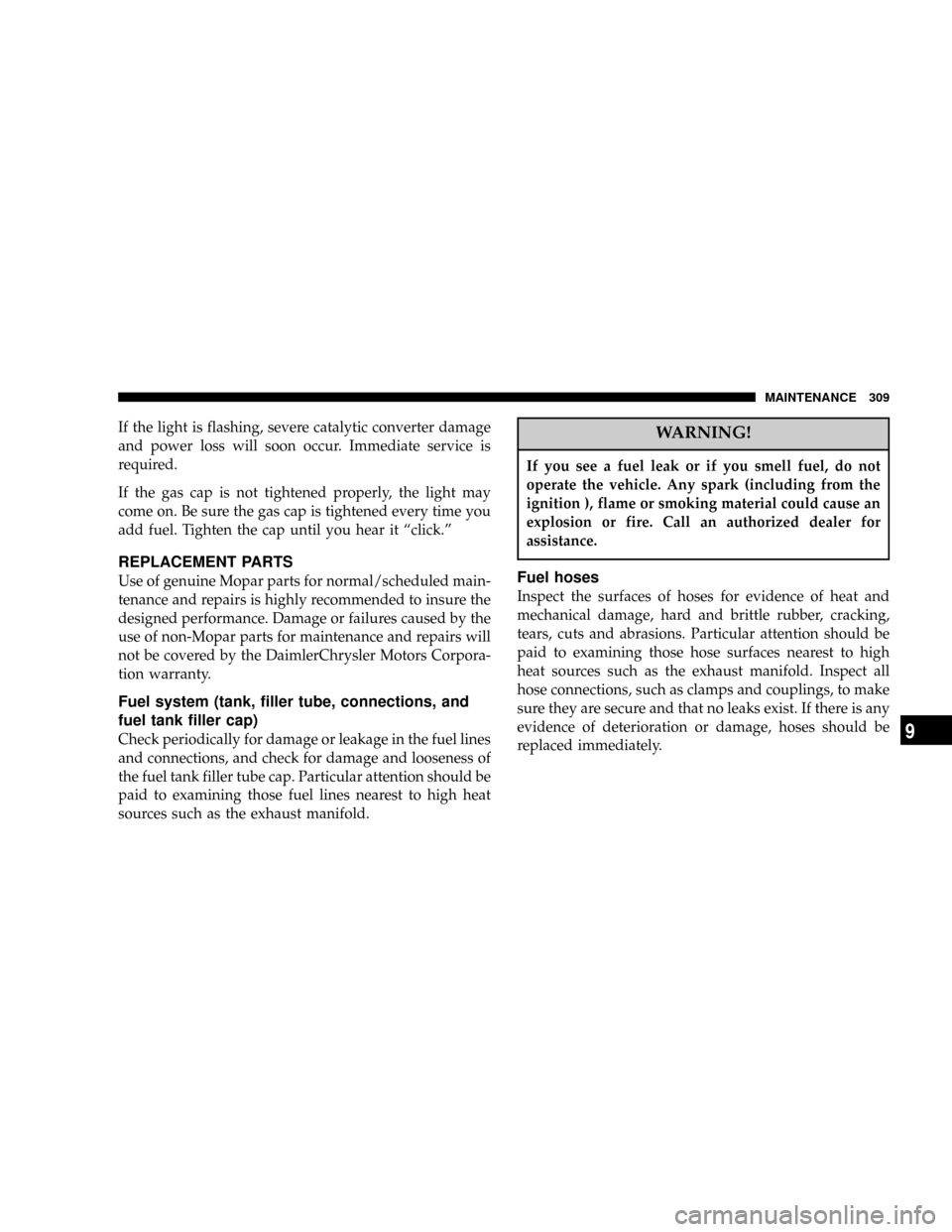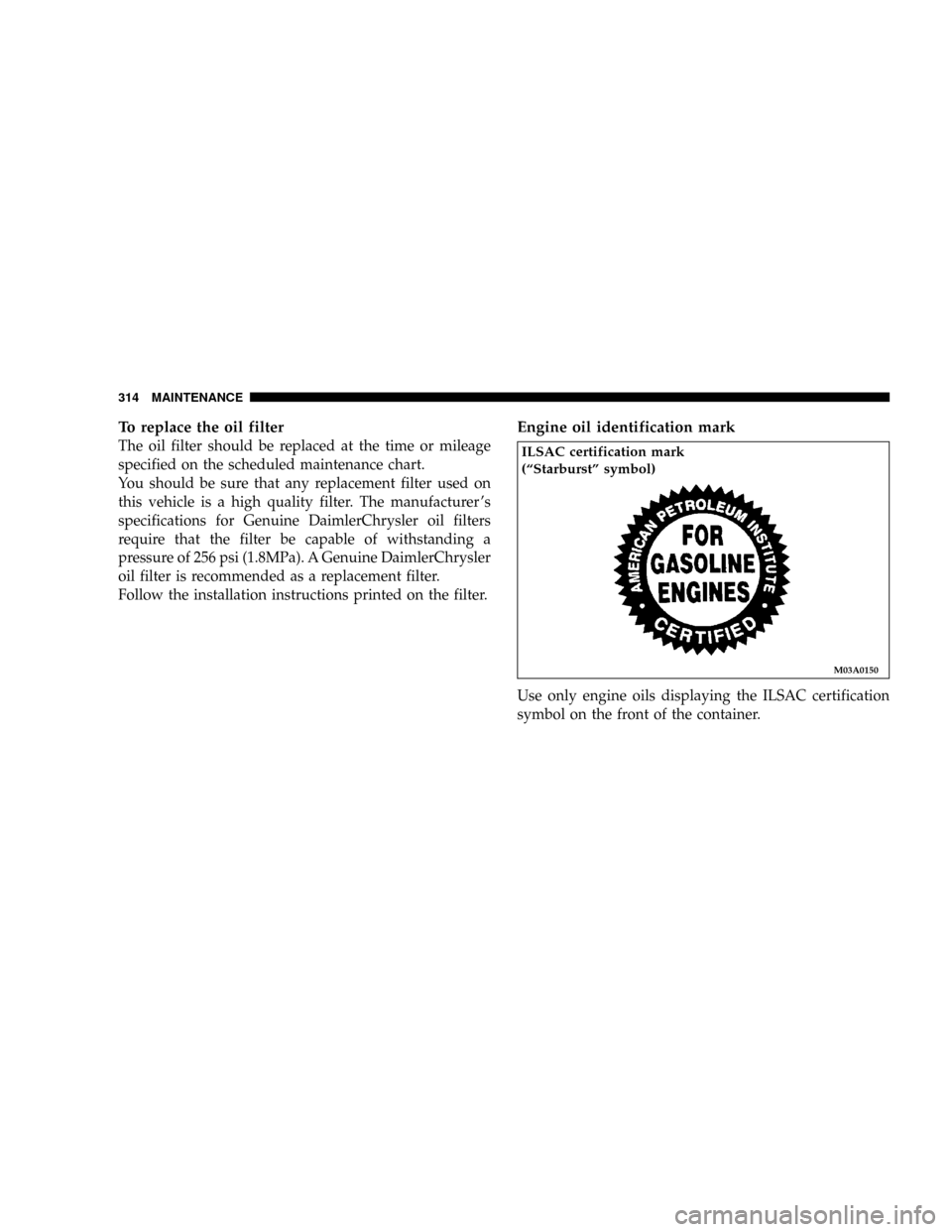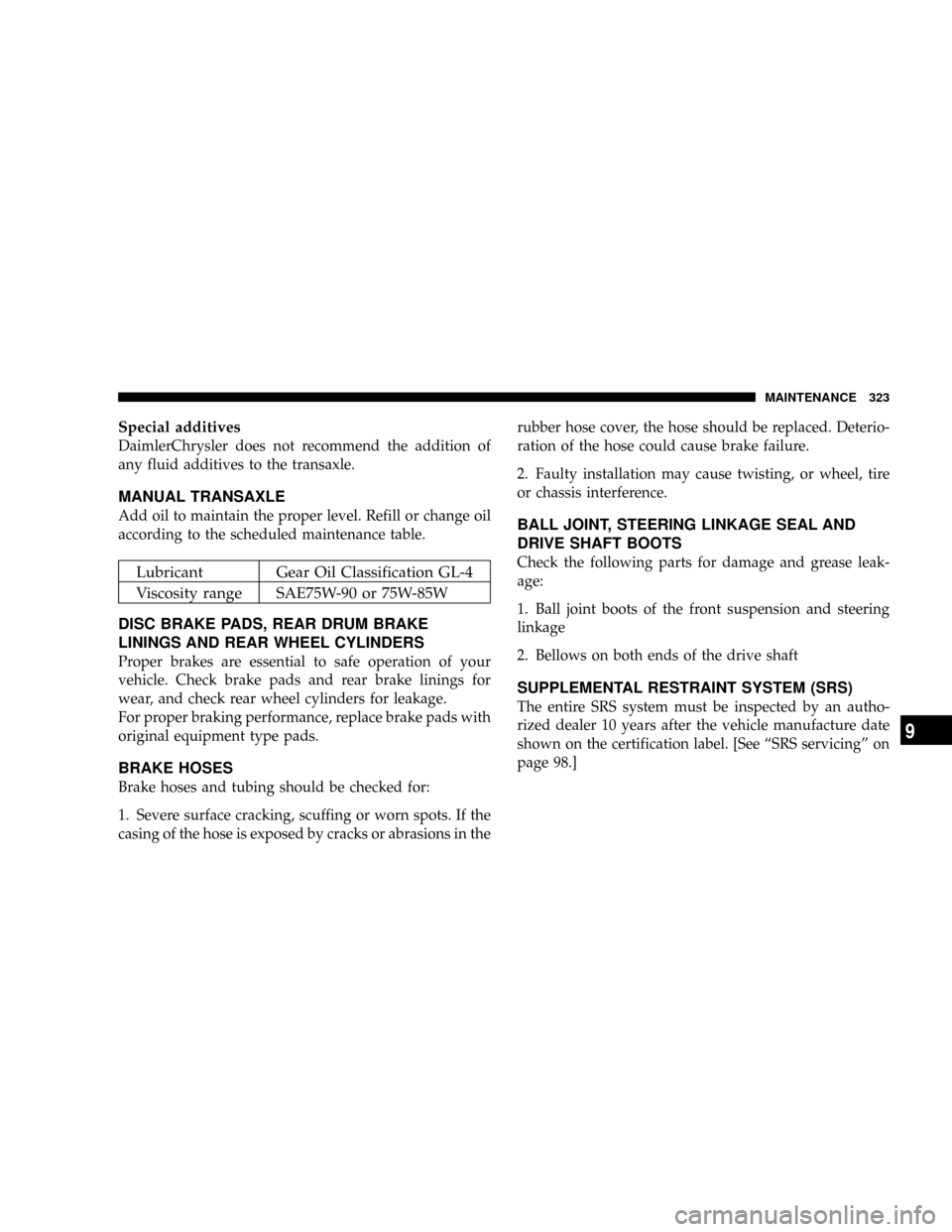2004 CHRYSLER SEBRING COUPE maintenance schedule
[x] Cancel search: maintenance schedulePage 304 of 382

NDisconnection and connection.............319
mAutomatic transaxle.....................321
NTo check the fluid level..................322
NProcedure for checking the fluid level.......322
mManual transaxle.......................323
mDisc brake pads, rear drum brake linings
and rear wheel cylinders.................323
mBrake hoses...........................323
mBall joint, steering linkage seal and drive
shaft boots...........................323
mSupplemental Restraint System (SRS)........323
mDoor hinges, rear hatch hinges, hood lock
release mechanism and safety catch
.........324
mExhaust system........................324
mWindshield wiper blades.................325
NWindshield washers....................325
mParking brake.........................326
mDrive belt (for generator, water pump, power
steering pump)
........................327
mTiming belt...........................328
mTi re s................................328
NTire inflation pressures..................328
NRadial ply tires.......................330
N
Tire pressure for sustained high-speed driving...330
NOversize tires........................330
NTire maintenance......................331
NCargo loads..........................331
NTread wear indicators...................331
NTire rotation.........................332
NTire chains...........................333
NSnow tires...........................333
mRegular Maintenance Schedule.............334
mSevere Maintenance Schedule..............343
304 MAINTENANCE
Page 306 of 382

NOTE: The Scheduled Maintenance Charts are located
in the rear of this maintenance section. Always refer to
the schedules for proper service intervals.
SERVICE PRECAUTIONS
Adequate care of your vehicle at regular intervals serves
to preserve the value and appearance as long as possible.
Some maintenance items can be performed by the owner,
while others should be done only by an authorized
dealer.
This section describes only those items which can be
performed by the owner. In the event a malfunction or
other problem is discovered, have it corrected by an
authorized dealer.
This section contains information on inspection mainte-
nance procedures that you can do yourself, if you so
desire. Follow the instructions and precautions for each
of the various procedures.
WARNING!
²When checking or servicing the inside of the
engine compartment, be sure the engine is
stopped and has had a chance to cool down.
²If it is necessary to do work in the engine com-
partment with the engine running, be especially
careful that your clothing, hair, etc. does not
become caught by the fan, drive belts, or other
moving parts.
306 MAINTENANCE
Page 307 of 382

WARNING!
²The fan may turn on automatically even if the
engine is not running; turn the ignition key to the
ªLOCKº position and remove the key to ensure
safety while you work in the engine compartment.
²Do not smoke, or allow open flames around fuel
or the battery. The fumes are flammable.
²Be extremely cautious when working around the
battery. It contains poisonous and corrosive sulfu-
ric acid.
²Do not get under your vehicle with just the car's
jack supporting it.
Always use properly rated automotive jack
stands.
²Improper handling of components and materials
used in the vehicle can endanger your personal
safety. Consult an authorized dealer if you have
questions.
EMISSION-CONTROL SYSTEM MAINTENANCE
Your vehicle is equipped with an emission-control sys-
tem which satisfies all requirements of the U.S. Environ-
mental Protection Agency. The emission-control system
consists of:
(1) a positive crankcase ventilation system
(2) an evaporative emission-control system
(3) an exhaust emission- control system.
The9Scheduled9maintenance services listed must be
performed at the times or mileages specified to assure the
continued proper functioning of the emission-control
system. These, and all other ªGeneralº maintenance
services included in this manual, should be performed to
provide the best vehicle performance and reliability.
More frequent maintenance may be needed for vehicles
driven under severe operating conditions such as dusty
areas and frequent start and stop driving.
In order to assure the proper function of the emission-
control system, it is recommended that you have your
vehicle inspected and maintained by an authorized
dealer in accordance with the schedule in this manual.
Inspection and service should also be performed any
time a malfunction is suspected.
MAINTENANCE 307
9
Page 309 of 382

If the light is flashing, severe catalytic converter damage
and power loss will soon occur. Immediate service is
required.
If the gas cap is not tightened properly, the light may
come on. Be sure the gas cap is tightened every time you
add fuel. Tighten the cap until you hear it ªclick.º
REPLACEMENT PARTS
Use of genuine Mopar parts for normal/scheduled main-
tenance and repairs is highly recommended to insure the
designed performance. Damage or failures caused by the
use of non-Mopar parts for maintenance and repairs will
not be covered by the DaimlerChrysler Motors Corpora-
tion warranty.
Fuel system (tank, filler tube, connections, and
fuel tank filler cap)
Check periodically for damage or leakage in the fuel lines
and connections, and check for damage and looseness of
the fuel tank filler tube cap. Particular attention should be
paid to examining those fuel lines nearest to high heat
sources such as the exhaust manifold.
WARNING!
If you see a fuel leak or if you smell fuel, do not
operate the vehicle. Any spark (including from the
ignition ), flame or smoking material could cause an
explosion or fire. Call an authorized dealer for
assistance.
Fuel hoses
Inspect the surfaces of hoses for evidence of heat and
mechanical damage, hard and brittle rubber, cracking,
tears, cuts and abrasions. Particular attention should be
paid to examining those hose surfaces nearest to high
heat sources such as the exhaust manifold. Inspect all
hose connections, such as clamps and couplings, to make
sure they are secure and that no leaks exist. If there is any
evidence of deterioration or damage, hoses should be
replaced immediately.
MAINTENANCE 309
9
Page 310 of 382

Air cleaner filter
The air cleaner filter will become dirty and loaded with
dust during use, and the filtering effect will be substan-
tially reduced. Replace it with a new filter in accordance
with the schedule in this manual.
1. Unclamp the air cleaner cover.
2. Take out the air cleaner filter.After replacing the air cleaner filter, reinstall the cover in
its original position.
CAUTION!
Take care not to damage the engine air flow sensor
when removing the air cleaner cover.
Evaporative emission control system (except
evaporative emission canister)
If the fuel-vapor vent line is clogged or damaged, the
fuel-vapor mixture will escape, polluting the atmosphere.
Have the system checked at an authorized dealer at the
mileage specified on the scheduled maintenance chart.
M23A0130
310 MAINTENANCE
Page 311 of 382

Spark plugs
Spark plugs must fire properly to assure proper engine
performance and emission-control.
Do not reuse spark plugs by cleaning or regapping. Spark
plugs should be replaced at the mileage specified on the
scheduled maintenance chart.
Your vehicle may be equipped with standard type spark
plugs or iridium tipped ones. Iridium tipped spark plugs
are identified by blue marks on the ceramic. They do notrequire replacement as frequently as the conventional
type spark plug and are designed to last much longer.
NOTE: Use the recommended or equivalent spark plugs
listed under ªEngine specificationsº on page 361.
Use of non-recommended plugs will cause engine dam-
age, loss of performance or radio noise.
Ignition cables
The ignition cables should be kept clean, properly con-
nected, and fully seated. Terminals should be fully seated
and should not be removed from the distributor or coil
towers unless they are damaged or cable testing indicates
high resistance or broken insulation. Cracked, damaged,
or faulty cables must be replaced.
Distributor cap and rotor
Check the distributor cap and rotor to maintain proper
function and good emission control.
P15A0340
Iridium tipped
type
MAINTENANCE 311
9
Page 314 of 382

To replace the oil filter
The oil filter should be replaced at the time or mileage
specified on the scheduled maintenance chart.
You should be sure that any replacement filter used on
this vehicle is a high quality filter. The manufacturer 's
specifications for Genuine DaimlerChrysler oil filters
require that the filter be capable of withstanding a
pressure of 256 psi (1.8MPa). A Genuine DaimlerChrysler
oil filter is recommended as a replacement filter.
Follow the installation instructions printed on the filter.
Engine oil identification mark
Use only engine oils displaying the ILSAC certification
symbol on the front of the container.
M03A0150
ILSAC certification mark
(ªStarburstº symbol)
314 MAINTENANCE
Page 323 of 382

Special additives
DaimlerChrysler does not recommend the addition of
any fluid additives to the transaxle.
MANUAL TRANSAXLE
Add oil to maintain the proper level. Refill or change oil
according to the scheduled maintenance table.
Lubricant Gear Oil Classification GL-4
Viscosity range SAE75W-90 or 75W-85W
DISC BRAKE PADS, REAR DRUM BRAKE
LININGS AND REAR WHEEL CYLINDERS
Proper brakes are essential to safe operation of your
vehicle. Check brake pads and rear brake linings for
wear, and check rear wheel cylinders for leakage.
For proper braking performance, replace brake pads with
original equipment type pads.
BRAKE HOSES
Brake hoses and tubing should be checked for:
1. Severe surface cracking, scuffing or worn spots. If the
casing of the hose is exposed by cracks or abrasions in therubber hose cover, the hose should be replaced. Deterio-
ration of the hose could cause brake failure.
2. Faulty installation may cause twisting, or wheel, tire
or chassis interference.
BALL JOINT, STEERING LINKAGE SEAL AND
DRIVE SHAFT BOOTS
Check the following parts for damage and grease leak-
age:
1. Ball joint boots of the front suspension and steering
linkage
2. Bellows on both ends of the drive shaft
SUPPLEMENTAL RESTRAINT SYSTEM (SRS)
The entire SRS system must be inspected by an autho-
rized dealer 10 years after the vehicle manufacture date
shown on the certification label. [See ªSRS servicingº on
page 98.]
MAINTENANCE 323
9